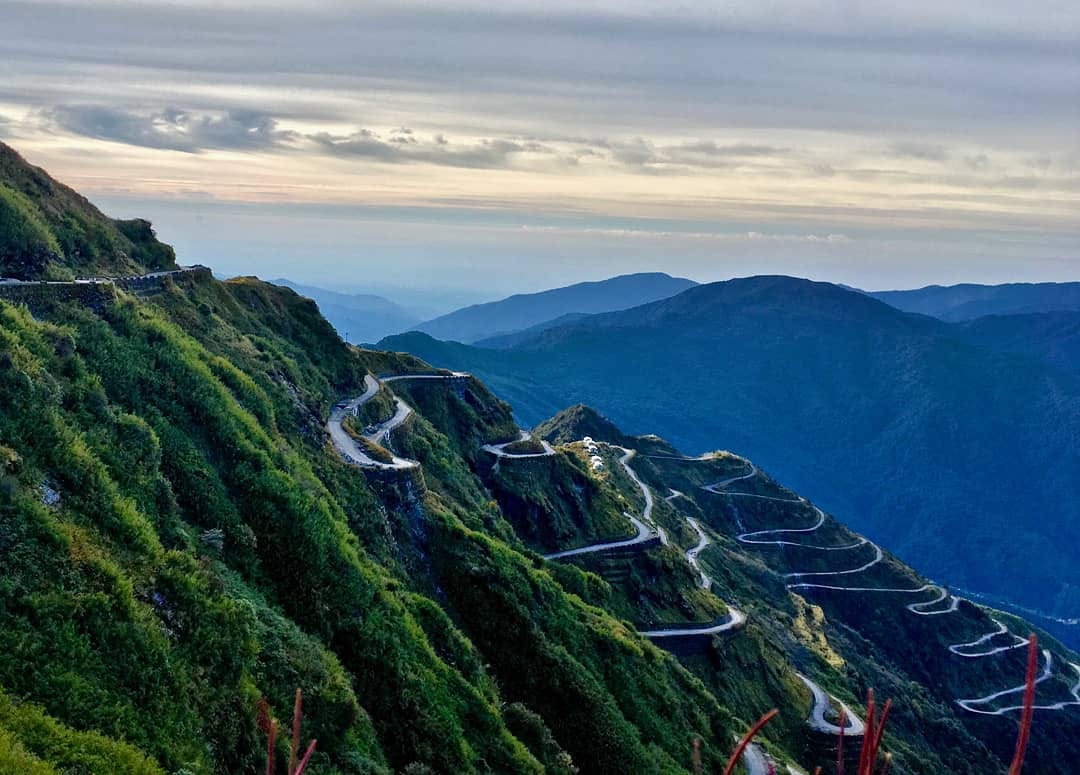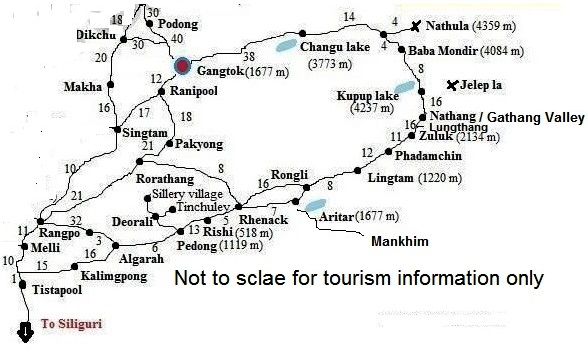Silk Route Tour Plan – A Complete Guide

The Old Silk Route in Sikkim is a historic trade route that once connected India through the plains of Bengal with the ancient Tibet. Traversing through rugged terrains and breathtaking landscapes, this fabled route continues to captivate travelers with its mystique and charm. Nestled in the lap of the Eastern Himalayas, the Silk Route in Sikkim offers a glimpse into the region’s rich history and mesmerizing natural beauty.
How it is named as Silk Route:
The Old Silk Route takes us on a journey back in time, where merchants from India and Tibet engaged in bustling trade of silk, spices, and other valuable goods. Today, this ancient trail serves as a gateway to explore the remote and untouched beauty of Sikkim. Starting from the small village of Zuluk, the route winds its way through lush green forests, high-altitude passes, and quaint mountain villages. Each step on this trail unveils the untold stories of the past.
Amazing Landscapes & Zigzag Roads:
As you travel along the Silk Route, you will be greeted by one breathtaking vista after another. The panoramic views of snow-capped mountains, terraced hills, and pristine valleys are simply awe-inspiring. The shimmering blue waters of Tsomgo Lake, the rugged beauty of Gnathang Valley, and the tranquility of Kupup Lake (Elephant Lake) add to the enchantment of the journey. Don’t forget to wake up early to catch the glorious sunrise from Thambi Viewpoint, where the first rays of light paint the peaks in hues of gold and orange.
Enjoy Local Experiences:
One of the highlights of exploring the Silk Route is the opportunity to stay in traditional homestays. The warm hospitality of the local hosts, the authentic Sikkimese cuisine, and the chance to participate in their daily activities provide a truly immersive experience. Engage in conversations with the villagers, learn about their customs, and witness their traditional dance and music performances.
Spirituality & Buddhist Monasteries:
Sikkim is also known for its vibrant Buddhist culture, and the Silk Route is dotted with several monasteries and stupas. Take a moment to visit the Baba Harbhajan Singh Mandir, a revered temple dedicated to a soldier who is believed to protect the area. The Tukla Valley also houses a war memorial that pays tribute to the brave soldiers who lost their lives during the Indo-China war. These spiritual sites offer a sense of serenity and introspection amidst the wild landscapes.
The Old Silk Route in Sikkim is not just a destination; it’s an unforgettable journey that leaves a lasting impression on every traveler’s heart. From its ancient tales to its unspoiled beauty, the Silk Route offers a unique and soul-stirring experience that beckons wanderers to come and explore its secrets. So, put on your traveling shoes, pack your curiosity, and embark on this extraordinary odyssey through the land of mountains and mystique.
Places to visit in Silk Route Sikkim
The Silk Route in Sikkim is a treasure trove of scenic beauty and cultural heritage. It offers several fascinating places to visit that will leave you in awe of the region’s charm. Here are some must-visit places along the Silk Route in Sikkim:
Zuluk (Dzuluk): This quaint mountain village is the starting point of the Silk Route. It offers breathtaking views of the surrounding hills and is famous for its winding roads with 32 hairpin bends called the “Zig Zag Road.” Don’t miss the sunrise from Thambi Viewpoint for a magical sight of the Kanchenjunga range.
Nathang Valley (Gnathang Valley): A high-altitude plateau with stunning landscapes, Nathang Valley is a picturesque destination on the Silk Route. It offers panoramic views of snow-capped mountains and is often covered in snow during the winter months.
Kupup Lake (Elephant Lake): This high-altitude lake is named Elephant Lake due to its shape resembling an elephant. Surrounded by snow-clad mountains, the lake offers a serene and picturesque setting.
Dalapchand: This is a small village after Kalimpong which comes under West Bengal.
Sillery Gaon: Sillery Gaon is situated in West Bengal and Sikkim border from where the Silk route starts. It is around 4-5hrs drive from Siliguri. Sillery Gaon is famous for it’s majestic view of Kanchanjungha range.
Icchegaon: This village is also a calm and quite village for those who are looking for a village life stay in Silk Route.
Rishikhola: This destination in Silk route is situated beside Rishi river which is very beautiful during full moon nights. There are a few homestays in Rishikhola but most of them are situated on the mountains so its not recommended for aged people who has knee pain or injuries.
Rongli: Rongli is the entry point of Silk route from where you will get the permits done. This is like a small town in this route.
Padamchen: This village is situated in the Silk Route and you might stay here for a night.
Lingtam: This small village also falls into enroute Zuluk.
Rolep: This village is named as per the river Rolep. A few homestays in Rolep is accomodating guests who they are visiting Silk Route.
Aritar: Aritar is a serene village with beautiful lakes and forests. Don’t miss visiting the Lampokhri Lake and Mankhim Temple for stunning views of the surrounding landscapes.
Mankhim: This village is known for its cardamom plantations and offers a peaceful retreat amidst nature. The Mangkhim view tower provides excellent views of the Himalayas.
Tukla Valley: This valley has significant historical importance, as it houses a war memorial in memory of soldiers who lost their lives in the 1962 Indo-China war.
Gnathang Valley: Another charming village along the Silk Route, Gnathang offers a quiet escape amidst the mountains and is perfect for nature lovers.
While visiting these places, ensure you respect the local culture and traditions, and practice responsible tourism to preserve the natural beauty of the region. The Silk Route is a unique and unforgettable journey that will leave you with cherished memories of Sikkim’s captivating landscapes and warm hospitality.
Where you should stay in Silk Route
To get an answer to this question you have to understand that the Silk route is a linear road which goes towards Zuluk and then to Gangtok via Tsomgo Lake and Baba Mandir. If we consider Nathang valley as the top point where tourists can stay and the lowest point of Silk route is Sillery Gaon the total distance is around 100km. So even if you stay 3 nights on a daily basis you just travel 35km in avg. You should make your plan at a distance of 35km from each night stay destinations.
This Silk Route Tourist Map will help you to plan your trip better.

Recommended Night Stay Options.
Sillery Gaon
Rongli
Padamchen
Zuluk
Aritar
Best Time to Visit Silk Route
You can visit Silk route anytime except Monsoon (June middle to Sept Middle). If you want to see snow you have to visit during March-May. But if you are travelling before mid of April avoid staying in Nathang or Zuluk. If you are travelling during winter keep heavy woolen jackets.
How to Reach Silk Route
You have to reach Siliguri / New Jalpaigudi if you are travelling by Train. If you are travelling by Flight you have to reach Bagdogra (IXB). Siliguri is also connected with Kolkata by overnight Volvo buses. Considering Sillery Gaon or Dalapchand as the first point for Silk Route you can reach there by hired vehicles. Its recommended to take a SUV rather than a hatchback car because of the road conditions. If you want to travel by public transport you can take buses to Kalimpong from Siliguri and then from Kalimpong you have to take a hired vehicle to reach Sillery or any other destinations in Silk Route.
Transportation in Silk Route
Hired vehicles are the only option to travel Silk Route. Tata Sumo / Boleros are better for road conditions. You can also take a Xylo or Scorpio for this trip. The best way to arrange vehicle is either you take it from any homestay you book or you book from some trusted tour operator in Kolkata / Siliguri. Reaching out there and booking local taxi wont be a good idea. Remember in Silk route cars wont be at your disposal. Cars will pick you up in the morning, will be there with you during the travel and then after dropping you to your hotel / homestay they will leave.
Silk Route Tour Cost
If you ask how does it cost for a Silk route package its not possible to answer however we can help you with the calculation by which you can calculate your own. Homestays will cost you from Rs.1000 – Rs1400 per day per head including 4 times meal. A Tata Sumo or Bolero will cost around Rs.4000/day. During Bijaya Dashami and Bhai phota (bhai duj) the price of cars might go very high due to unavailability of cars.
Homestays in Silk Route
All the mentioned places have homestays and they provide simple homely food and basic stays. You can book Silk Route Homestays from www.fusionstays.com. Tourism in Silk route is still under development and therefore the homestays are basic so if you are coming to Silk Route please come with an anticipation that there will be small issues everywhere. You have to ignore those small things and enjoy the nature.